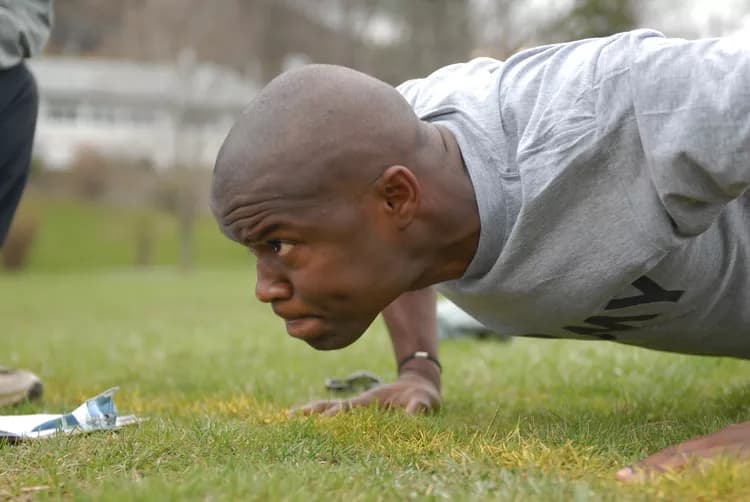The push-up is a typical strength building exercise that uses your body weight with gravity to condition muscles. Many fitness experts agree that this is the best upper body resistance exercise, which is why military branches use it for their physical training practices. They are also a common form of punishment used in school sports and some martial arts dojos. Anyone can perform the push-up without the need for any expensive exercise equipment.
There are many variations of the push-up including the following:
- Standard Push-up: Kneel down on your hands and feet. Your hands should be slightly outside shoulder-width apart. Straighten your arms and legs and hold your feet together. Your body should form a plank from your ankles to the top of your head. Lower your chest to an inch above the floor, keeping your elbows at your sides and push back up.
- Leg-Kick Push-up: Assume the standard push-up position. Then, lower your body until your chest is one inch above the floor. As you are lowering your chest, kick your right leg out to the side as close to a 90-degree angle as possible without bending your knee. As you are pushing yourself up, move your leg back to the starting position. Repeat with your left leg.
- Knee-to-Opposite-Elbow Push-up: Form fists with your hands and assume the standard push-up position. Your knuckles should be flat against the floor. Bring your right knee to your left elbow, and hold that position before returning your leg to the starting position. Now, lower your body as you would for a standard pushup. Press back to the starting position and repeat, this time bringing your left knee to your right elbow.
Each of these variations of doing push-ups has its advantages and they carry similar health benefits. The push-up is a compound exercise and works out a number of different muscles simultaneously. Push-ups can be challenging because they work multiple muscle groups at once. The push-up works out your chest, biceps, triceps, abs, lower back muscles, quadriceps, and anterior deltoids. In addition, you will notice that performing push-ups regularly will tone your forearms and wrists.
Stretching is just as important as strength training. Luckily, you stretch your back and biceps when you perform a push-up. A good stretch can help you feel limber, improve the appearance of your muscles, and protect you from injuries. In addition, performing push-ups can prevent body damage by stabilizing the supporting muscles.
Push-ups can also enhance your quality of life by improving your posture. Using proper technique and keeping your back straight through the exercise will teach your body how to stand up straight. Correct posture will reduce back pain.
One of the benefits of push-ups is that as you are performing one, your heart is receiving more blood. Push-ups improve blood circulation and help protect the heart. A healthy heart decreases the risk of stroke, heart disease, and other illnesses.
Performing pushups also stimulates the metabolism, allowing you to burn more calories throughout the rest of your workout. Dr. Kaiser and colleagues found that a high intensity, heavy resistance exercise is connected with an energy utilization rate.
A review, published in the Journal of Strength and Conditioning, shows that performing pushups can help increase testosterone levels. Testosterone is known for giving individual masculine characteristics, causing a rapid growth in lean muscle mass and strength. The small steroidal molecule is primarily responsible for growth the growth of muscle and bone mass, as well as facial hair.
Research from the Journal of Applied Physiology found a rapid surge in plasma growth hormone after low-intensity resistance exercise. Human growth hormone helps your muscles to grow as well. Our bodies produce human growth hormone in larger quantities when we are young, but create less as we age. If you have a hard time gaining muscle mass, try more repetitions and variations of push-ups.
Additional Resources:
Cogley, R. M., Archambault, T. A., Fibeger, J. F., Koverman, M. M., Youdas, J. W., & Hollman, J. H. (2005). Comparison of muscle activation using various hand positions during the push-up exercise. The Journal of Strength & Conditioning Research, 19(3), 628-633.
LaChance, P. F., & Hortobagyi, T. (1994). Influence of cadence on muscular performance during push-up and pull-up exercise. The Journal of Strength & Conditioning Research, 8(2), 76-79.
Loebel, C. C., & Kraemer, W. J. (1998). Testosterone and resistance exercise in men. The Journal of Strength & Conditioning Research, 12(1), 57-63.
Rubini, E. C., Costa, A. L., & Gomes, P. S. (2007). The effects of stretching on strength performance. Sports medicine, 37(3), 213-224.
Takarada, Y., Nakamura, Y., Aruga, S., Onda, T., Miyazaki, S., & Ishii, N. (2000). Rapid increase in plasma growth hormone after low-intensity resistance exercise with vascular occlusion. Journal of Applied Physiology,88(1), 61-65.
Zetlin, S. (2012). Push-Up Progression Workout for a Stronger Core: A Twelve Push-Up Journey. Price World Publishing.
Helpful Peer-Reviewed Medical Articles:
Fortier, M. D., Katzmarzyk, P. T., Malina, R. M., & Bouchard, C. L. A. U. D. E. (2001). Seven-year stability of physical activity and musculoskeletal fitness in the Canadian population. Medicine and Science in Sports and Exercise, 33(11), 1905-1911.
Lieberman, L., & McHugh, E. (2001). Health-related fitness of children who are visually impaired. Journal of Visual Impairment & Blindness (JVIB), 95(05).
Beets, M. W., & Pitetti, K. H. (2005). Contribution of Physical Education and Sport to Health‐Related Fitness in High School Students. Journal of School Health, 75(1), 25-30.
Beach, T. A., Howarth, S. J., & Callaghan, J. P. (2008). Muscular contribution to low-back loading and stiffness during standard and suspended push-ups. Human Movement Science, 27(3), 457-472.
Related Articles
Test Your Knowledge
Asked by users
Related Centers
Related Specialties
Related Physicians
Related Procedures
Related Resources
Join DoveHubs
and connect with fellow professionals


0 Comments
Please log in to post a comment.